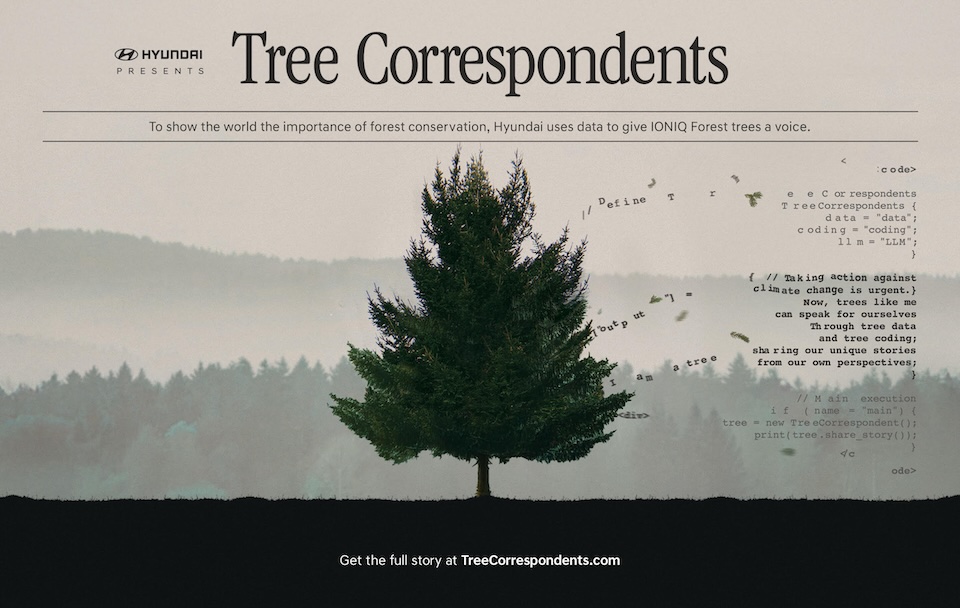How FCB N.Y. Used AI and Data to Give Trees a Voice
Hyundai gauges the shifting rhythms of the natural world

What if a tree could talk? What would it say about the shifting rhythms of the natural world?
That was the question behind “Tree Correspondents,” a project we created for Hyundai.
The idea was simple: Let people hear directly from trees living through climate change. We had to create a new language that allowed these silent witnesses to tell their stories.
We had to start by building a system that could listen, but could also interpret data and create new narratives. That’s where Uncharted Limbo came in. With them, we developed an LLM that combined real-time information from the trees, scientific insights and historical climate data.
We worked with Meter Group to install live sensors on trees in Hyundai’s IONIQ Forests in Brazil, South Korea and Czechia. These sensors collected real-time stats from the trees and their surroundings—like soil moisture, precipitation levels and air temperature. The Weather Company also gave us historical satellite data from each tree’s location. All of that fed into our custom LLM, which ingested the data, uncovered patterns and created a distinct “voice” for each tree to report on its surroundings.
We always planned for humans to guide the process, not leave the storytelling entirely to AI. The trees themselves were clearly passionate about the ongoing climate crisis. So passionate, that many of their early dispatches read more like poetry. Our trees were storytellers—sometimes spitting out phrases like “the winds of change whispered through my needles”—but they needed a human hand to shape their dispatches into something more concrete, legible and impactful. Our creative team acted as editors, refining the tone of voice needed to properly convey the message.
One of our biggest challenges was balancing scientific integrity with emotional storytelling. We didn’t want to turn the trees into cartoon narrators, and we also knew that pure objectivity wouldn’t make anyone feel anything. So, we found a middle ground with journal entries that are rooted in fact, but shaped by feeling. For example, here’s an excerpt from a Fir tree in Czechia: “At this pace, our suitable habitats could retreat northward and upward at a rate of almost 25 kilometers per century—far beyond our ability to keep up.”
We also had to create campaign content to share alongside the articles themselves. Which meant a global production in three vastly different yet equally remote locations, all planned, filmed and edited within just a couple months. It also meant working in many different time zones, and traveling from the humid, mosquito-ridden jungles of Brazil to the frigid, wintry forests of Korea. Which came with its own set of logistical challenges.
In Korea, we were met with frozen ground, and struggled for hours to properly install our sensors. In Brazil, we installed the sensors easily. But then a lack of internet connectivity required us to quickly rethink our data collection plan. Even when we encountered challenge after challenge, we always found a solution as a team.
With this project, we realized that creating emotion is a form of experience design. It wasn’t just about telling a data-informed story. It was about making someone feel something when they read these journal entries.
When it comes to climate change, most people are overwhelmed by statistics or desensitized by the scale of the problem. But hearing a real tree say, “this is a stressful situation” can cut through in a way no stat ever could. It makes the invisible impacts of a warming planet feel personal, and that was the point.
As a producer, I’m used to managing timelines, global production partners and budgets. But this project reminded us that creativity can emerge from data. And stories from a non-human yet sentient being can still feel deeply human.
We didn’t give trees a voice. We built a way for people to finally hear them.



 Events
Events
